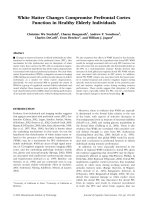PRACTICAL INSTRUCTION IN OBSTETRIC & GYNECOLOGICAL NURSING doc
Bạn đang xem bản rút gọn của tài liệu. Xem và tải ngay bản đầy đủ của tài liệu tại đây (71.4 KB, 5 trang )
1
PRACTICAL INSTRUCTION IN
OBSTETRIC & GYNECOLOGICAL NURSING
COURSE DIRECTOR: JING ZHANG, PhD
School of Nursing
Second Military Medical University
REVISED 12/2010
2
I. WELCOME / COURSE BASICS
Welcome to Obstetrics & Gynecology!
The Obstetrics & Gynecology core clinical study focuses on health care of women during the reproductive
and post-reproductive years. The course emphasizes care of the pregnant female, normal labor and delivery,
common obstetrical and gynecologic problems, preventive care, screening for gynecologic malignancies, and
family planning and sexuality.
You have been assigned to one of two hospitals for your clinical experience. In general, you will attend three
clinical sites, ie the Obstetrics in-patient unit, the Gynecological in-patient unit, and the O&G outpatient
clinics. The course coordinator at each site will provide you with a detailed schedule of your clinical
assignments. Before you go to hospital, we also provide a chance to help you improve some special skills
related to your clinical experience in O&G skill traing lab.
Please note: specific site information may change from time to time.
II. CLINICAL SITES
The Changhai Hospital
Course Director: Jie Cao, PhD
Course coordinator in Obstetric in-patient unit: Xiuli Zhang
Course coordinator in Gynecological in-patient unit: An Liu
Course coordinator in O&G outpatient clinics: Huanglu Tao
The Changzheng Hospital
Course Director: Dongmei Yu, MD
Course coordinator in O&G inpatient unit: Ruiling Pu
The School of Nursing O&G skill traing lab
Course Director: Jing Zhang, PhD
Course coordinator: Lingjun Zhao, PhD
III. CLINICAL LEARNING OBJECTIVES
A. Obstetrics
At the end of the course, students are expected to:
Knowledge:
1. Understand the management of labor and delivery of a low-risk patient.
2. Understand the indications for cesarean section.
3. Understand indications for antenatal testing (i.e., non-stress test, biophysical profile).
4. Understand the differential diagnoses for third trimester bleeding.
5. Recognize the presentation for preeclampsia and other hypertensive disorders of pregnancy.
6. Understand the basic management of common medical conditions during pregnancy including
hypertension, asthma, thyroid disorders and diabetes.
7. Understand the basic management of common pregnancy complications such as third trimester bleeding,
preterm labor and hypertensive disorders in pregnancy.
8. Recognize the presentation, recognition and initial management of post partum mood disorders.
9. Understand the differential diagnosis and basic management of postpartum hemorrhage.
10. Understand the differential diagnosis and basic management of postpartum fever/sepsis.
11. Understand the principles of prenatal care including the reasoning behind routine and problem directed
3
prenatal labs as well as the timing and elements of prenatal visits.
Skills:
1. Obtain history and perform physical exam on a pregnant patient during antepartum visit and on admission
to labor and delivery.
2. Be able to describe a normal labor and delivery and perform basic maneuvers to assist a spontaneous
vaginal delivery.
3. Understand the assessment of labor progress by vaginal exam.
4. Be able to interpret a fetal monitor strip and recognize normal and abnormal FHR tracing.
5. Be able to work with the Obstetric team in response to Obstetric emergencies.
6. Be able to measure uterine size after 16 weeks and evaluate fetal heart tones by Doppler or stethoscope.
Behavior/Attitude:
1. Observe obstetrical ultrasound examinations and be able to recognize gross anatomical fetal structures.
2. Become culturally competent in interacting with pregnant women and their families from different cultural
backgrounds/beliefs
3. Be able to appropriately support actively laboring patients.
4. Understand how to integrate into a clinical care team as a nurse student/future nurse.
5. Follow labor and postpartum course /follow up on infant of assigned obstetricl patients
B. Gynecology
At the end of the course, students are expected to:
Knowledge:
1. Understand age specific recommendations for preventive care in women.
2. Understand the principles and practice of providing family planning services (risks and benefits, side
effects, efficacy).
3. Understand the physiology and normal variations in the menstrual cycle, be able to recognize when
bleeding is considered abnormal.
4. Understand the differential diagnosis and basic work up/management of first trimester vaginal bleeding.
5. Understand the differential diagnosis and basic work up/management of pelvic pain
6. Understand the differential diagnosis and basic work up/management of abnormal bleeding
7. Understand the common presentations, diagnostic methods and staging of gynecologic cancers and
basics of and long-term follow-up of treated patients.
8. Understand the indications for operative management of common gynecologic conditions such as uterine
myomata, ovarian cysts, ectopic pregnancy, and incomplete abortion.
9. Correlate pre-operative diagnosis with operative findings and pathologic findings.
10. Observe and understand indications for laparoscopic surgery.
11. Understand routine-post-operative care after major and minor gynecologic surgery.
12. Observe and understand the role of the tertiary specialist in reproductive endocrine disorders and
infertility and in gynecologic oncology.
13. Understand the presentation, diagnosis and treatment of common sexually transmitted diseases, pelvic
inflammatory disease and vaginitis.
14. Understand the physiology, diagnosis and principles of treatment of common gynecologic issues for
women in their post-reproductive years including menopausal symptoms, atrophic vaginitis and pelvic organ
prolapse.
15. Understand the physiology, work-up, diagnosis and treatment options for female urinary incontinence.
16. Understand the common symptoms of the menopausal transition as well as risks and benefits of current
4
treatment options.
Skills:
1. Obtain history (including sexual and menstrual history) and perform a physical exam (including breast and
pelvic exam and pap smear) on patients presenting for routine visit and common gynecologic conditions in
gynecology and/or family planning clinic.
2. Be able to maintain sterile technique in the operating room.
3. Be able to counsel appropriate patients regarding contraceptive methods.
4. Be able to interpret and make management recommendations for both normal and abnormal pap smears.
5. Be able to prepare and interpret a wet mount of vaginal discharge.
Behavior/Attitude:
1. Be culturally sensitive and competent in patient counseling surrounding sexual and family planning issues.
2. Become comfortable in screening for domestic violence and in referral for assistance for victims of
domestic violence.
3. Follow pre and postoperative course /follow up on pathology of assigned surgical patients
4. Understand how to integrate into a clinical care team as a nurse student/future nurse.
IV. EVALUATION / ASSESSMENT
Your performance during the clinical study is evaluated by your on site director and yourself. On-site directors
are responsible for gathering local clinical evaluation input and providing with written comments and
assigning a clinical performance grade. Yourself are responsible for evulation of your performance during the
clinical study.
The competencies on which you are evaluated are listed below:
PATIENT CARE
History-taking
Physical examination
MEDICAL KNOWLEDGE
Actual knowledge
Problem solving
PRACTICE-BASED LEARNING AND IMPROVEMENET
Integration of instruction
Efficiency and effectiveness
INTERPRERSONAL AND COMMUNICATION SKILLS
Humanism and interpersonal skills
Oral presentations
Written work
PROFESSIONALISM
Skills in dealing with diversity and cultural differences
Feedback/constructive criticism
Commitment
SYSTEMS-BASED PRACTICE
Collaborative practice skills
Disease prevention/routine health maintenance
Cost-consciousness
V. CORE PRACTICAL CONTENTS
5
Practices in Obstetric in-patient unit
Normal Labor and Nursing management: essential factors of labour, Stages and onset; Role of nurse
midwifery practitioner
Normal puerperium and nursing management; Role of nurse midwifery practitioner
Normal Newborn
Practices in Gynecological in-patient unit
Nursing assessment, nursing producedure before and after gynecological operations
Common disorders in Gynecological unit
Practices in O&G outpatient clinics
Maternal adaptation: Physiocological , Psychosocial
Prenatal examination
Family planning operation
Practices in O&G Skill Training Lab
Nursing care for the newborn
Prenatal examination producedure
Prenatal care
Gynecological physical examination
V. BASIC SURVIVAL FOR ALL SERVICES
These “survival guides” were developed for how to get the most out of your Ob Gyn rotation.
1. Be on time.
2. Find the chief and introduce yourself as the Nurse Student as soon as you arrive on the floor your first day.
3. Introduce yourself to the nurses and other residents and attendings and re-introduce yourself each time
you need a nurse’s help or scrub on a new case and each time you work with a different resident or
attending.
4. Expect it to be hectic at all times. Be interested and look for opportunities to follow patients and participate.
If you wait to be invited, you will miss out on clinical experiences,
5. Please do not sit at the main resident’s desk in the delivery room or on post op floors and read. You will be
in the way. Read somewhere else if there is absolutely nothing else to do and you can sew a nd tie knots like
a champ.
6. Expect ONLY to participate in the care of patients to whom you take the time to introduce yourself.
The more closely you follow your pts and the more interested and helpful you are, the more you will learn
and the more deliveries and procedures you will do!









